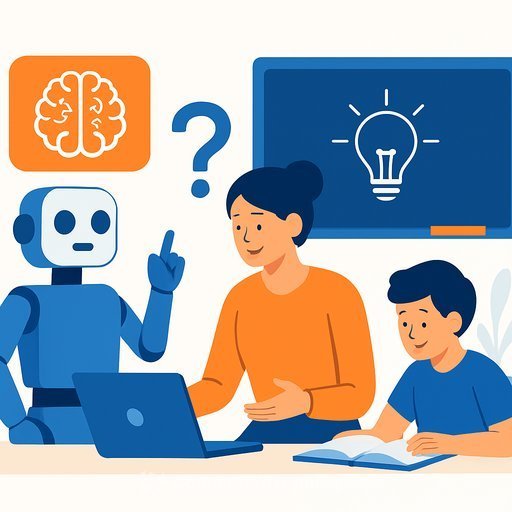Colleges Are Surrendering to AI - Here's the Better Strategy
We're at a strange point with AI. Everyone knows it will reshape how we learn and work, yet the day-to-day impact still feels easy to ignore on campus.
That gap fuels a quiet crisis. Most classic assignments-essays, problem sets, even lab write-ups-can be outsourced to chatbots with passable results. Grade inflation smooths the rest.
The uncomfortable truth
Essays in the humanities and social sciences are now easy targets for tools like ChatGPT. The best students still outperform machines, but many can cruise to an A- with AI and a light edit.
STEM isn't immune. Models that can ace olympiad-style questions won't struggle with routine problem sets. Detection is unreliable, enforcement is awkward, and the bureaucracy is slow.
So the default response has been denial. Or quiet acceptance. Some students pretend to learn. Some professors may soon pretend to grade with AI. That loop is unsustainable.
What's coming next
Incoming students will show up fluent in AI. They'll finish traditional assignments faster and sometimes produce "impressive" work that hides weak thinking.
GPAs will tell employers less about actual ability. Meanwhile, core skills-clear thought, precise writing, rigorous reasoning-will atrophy if we let AI do the heavy lifting too early.
The fix isn't ban or binge. It's both.
Students need two things: the ability to think clearly without help, and the ability to use AI as a force multiplier when it's appropriate. Pick one and you fail them.
Writing still matters because writing is thinking. On paper, fuzzy ideas fall apart. You find the gaps, the leaps, the shortcuts you took in your head. That struggle builds the judgment AI can't replace.
A two-track model for AI-era assessment
Track 1: No-tech to build core skill
- In-person, pen-and-paper exams with open-ended prompts that require argument, evidence, and structure.
- Oral defenses and whiteboard sessions to test reasoning under pressure and without tools.
- Rotating question banks and case variations to limit memorization and shortcuts.
- Rubrics that reward clarity of thought, logical flow, and use of course material over prose polish.
Track 2: AI-forward to build tool fluency
- Explicit permission to use AI for research, brainstorming, outlining, coding, and iteration.
- Mandatory AI use log: include prompts, key outputs, edits, and decisions appended to the submission.
- Assessment focused on originality, synthesis, correctness, and the student's judgment in using AI-not on surface-level style.
- Require a short reflection: what the AI got wrong, how the student corrected it, and what they learned.
Policy and practice you can adopt this term
1) Clear course policy
- State where AI is prohibited and where it's encouraged. No gray zones.
- Detection tools are fallible; do not rely on them alone. Use follow-up oral checks when work looks misaligned with prior performance.
2) Standardized AI documentation
- Provide a simple template for students to record AI usage (prompts, versions, key outputs, editing steps).
- Require citations for any AI-generated content that contributes facts, code, or structure.
3) Rubrics that reward thinking
- Weight argument quality, evidence, and problem-solving steps higher than polish.
- For AI-enabled work, grade the decision-making and verification process.
4) Practical exam logistics
- Seat maps, paper booklets, and timed windows for no-tech exams.
- Alternate versions per section. Include one "surprise" prompt that forces synthesis, not recall.
5) Faculty and TA upskilling
- Run short workshops on prompt craft, verification, and AI pitfalls like hallucinations.
- Build a shared prompt and assignment library. Calibrate grading with sample AI and non-AI submissions.
- If you need structured learning paths, see curated options at Complete AI Training.
6) Integrity with due process
- Flag suspicious work with a quick viva voce: a 5-10 minute discussion to confirm authorship and method.
- Document outcomes. Keep it simple and fair; students should know the process before the course begins.
Sample course blueprint
Midterm: a three-hour, in-person exam. Three short essays on core themes. No devices. The goal is to see independent reasoning, recall, and structure on demand.
Final: a research project where AI use is encouraged. Students submit the final paper plus an AI usage log and a short reflection on what they verified and why. You grade the contribution, the judgment, and the rigor of verification.
Signal value to employers
- Build portfolios with both kinds of evidence: no-tech essays and AI-assisted projects with usage logs.
- Offer brief faculty statements that speak to a student's independent reasoning and their tool fluency.
Why this works
Think of pilot training. You learn to fly a simple Cessna without gadgets, and you learn to manage a 787 packed with them. Both skills matter. One builds judgment. The other builds scale.
Students deserve the same. Teach them to think on their own. Teach them to use AI well. Do both and the degree means something again.
Further reading
Your membership also unlocks:






